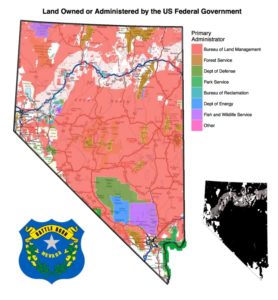
How Federal Policy Prices Nevadans Out of Housing
Nevada can be a tough place to call home. The state has plenty to offer in way of opportunity, outdoor activities and entertainment. Where it comes up short is affordable housing.
This seems counterintuitive as the state is among the least densely populated in the nation, with 3.3 million people spread across 70.28 million acres. Part of the problem is that more than 80 percent of Nevada is owned by the federal government.
Nevada has the dubious honor of having the highest percentage of federally owned land. As a result, fully four of every five acres of the Silver State cannot be built on by private individuals.
Such a large amount of development-restricted land means fewer homes and apartments being built, and higher prices for existing housing, as Nevada Policy explains in The Construction of a Crisis.
The just-released report is the first in a series that looks at Nevada’s housing situation, including why it’s so expensive. In this study several factors are identified: Regulations, building costs and the fact that far more people are moving into the state than leaving.
 But a major part of the problem behind the dearth of affordable housing lies with the limited amount of private land available for development.
But a major part of the problem behind the dearth of affordable housing lies with the limited amount of private land available for development.
Consider Las Vegas, where approximately 90 percent of the 8,000 square miles that make up Clark County is government owned. Between April 2021 and April 2022 the median price of a previously owned single-family home jumped 19 percent.
In Washoe County, where housing prices have also spiked, 83 percent of land is out of private hands.
Imagine what would happen if just a fraction of federal land in the two counties were suddenly opened to private ownership? The average price of housing would almost certainly drop as new construction would begin to relieve pent-up demand.
How did this situation come about? Nevada’s 1864 constitution explicitly stated that the state wouldn’t claim any public land not already spoken for, according to information found on the Bureau of Land Management’s website.
Nevada isn’t the only western state with significant federal holdings. The U.S. government owns 47 percent of all land in the western U.S. In the Midwest, much of the land was once owned by the federal government, but it was transferred to state governments and individuals through land grants and homesteading, according to a 2016 article by the New York Times.
Rugged terrain common throughout the West kept a much larger share of land in federal hands. Settlers took possession of the areas that held valleys conducive to farming, but the many mountainous, arid and difficult-to-reach tracts of land in the West simply weren’t attractive to settlers, the Times wrote.
“The only thing most of the remaining land was good for was grazing, but cattle ranchers and sheep herders needed large tracts of land to feed their livestock, not the smaller parcels they could claim through homestead policies,” the paper added.
Of the nearly 57 million acres of Nevada owned by the U.S. government, nearly 50 million are managed by the Bureau of Land Management, another 5 million are managed by the U.S. Forest Service and the remaining 5 million are divided among military installations, Native American reservations, wilderness areas and wildlife refuges.
Interestingly, there is a significant (in a relative sense) amount of private land in north-central Nevada, running from just west of Reno in a winding fashion along much of the Humboldt River to the east of Wendover.
This is land that was allocated to the Central Pacific Railroad for construction of the Transcontinental Railroad in the 1860s.
Under land-grant transfers from the federal government to Central Pacific, odd numbered sections were granted to the rail line in a corridor extending 20 miles on each side of the route. The government retained the even-numbered sections, thus creating a checkerboard pattern of alternate privately and publicly held land.
Later, this line became the Southern Pacific and today is operated as part of the Union Pacific.
Much change has taken place in the more than 150 years since rails were laid across Nevada to help complete the rail line linking east and west, but the federal government’s role as the state’s largest landlord remains firm and unyielding.